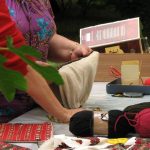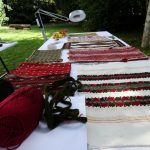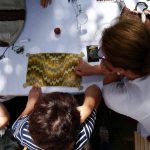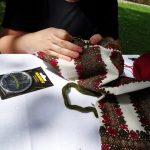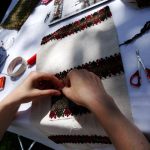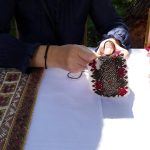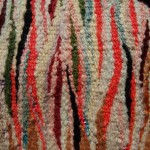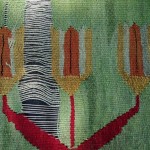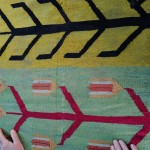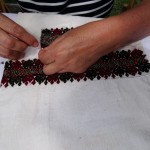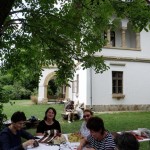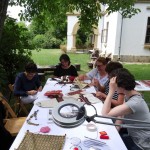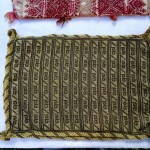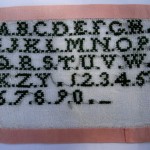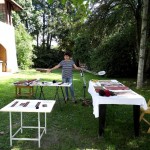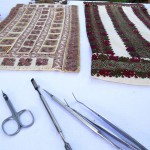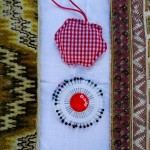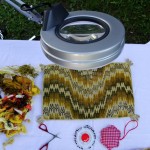
Photo gallery 2015
Photo gallery 2016
Between 13 and July 19, 2015, at Villa Golescu in Campulung, held workshop of textile conservation and restoration under the guidance of Mrs. Carmen Marian, textile restoration expert. The workshop was organized by the Pro Patrimonio Foundation.
Why a workshop for conservation and restoration of textile? Because textiles are an important part of the value of cultural heritage to be rediscovered, preserved and transmitted on future generations. Textiles constitute testimonies of technology, fashion, aesthetics, social life a certain period enabling new aspects of knowledge of events related to the daily life of the old days.
The project aimed at raising awareness of the perishable nature textile heritage and the importance of conservation and restoration work, proposing an approach to domain explained.
For one week, a group of ladies occupations and preoccupations in the most diverse fields – architecture, engineering, jewelry, computer science, history, education – was met at the Villa Golescu to explore the fascinating world of textiles.
The workshop started with a presentation of case studies on archaeological textiles dated sec. XVII / clothing items that belonged to personalities of Romanian century. XIX-XX. Through images, participants had the opportunity to go behind the scenes of a restoration-conservation laboratory, to become familiar with this area, to find work hiding behind a heritage object before it reach the exhibitions. On this occasion, participants had the opportunity to note the complexity of restoration and conservation, to know the physico-chemical research, technological, historical, artistic etc. object and then work execution itself.
Based on the fundamental principles that guide preventive conservation, the curative and then restore the talks focused on concrete situations that have focused mainly on issues regarding the cleaning of textiles, how to strengthen the reunion / reconstitution gaps arising degradations sustained over time, the textile items.
The second part of the workshop was developed in the work of conservation and restoration of several textile pieces belonging Villa Golescu. Challenge workshop was reconstruction of embroidery techniques used by old ladies to beautify objects of common use clothing or textiles, traditional techniques specific muscelean land handed down from generation to generation. For several days in a charming atmosphere, passionate and skillful ladies shared information about local culture and customs losses, while the fabrics of their hands has regained strălucirea.Vila Golescu 3 cushions restored and can be seen all visitors to the villa.
The first workshop of the textile conservation and restoration was a voluntary act Heritage textile, paving the way for future editions and had fashioned the foundation of informal meetings between women from different corners of the country, passionate and active.
Dr. Ing. Carmen Marian is a specialist in the restoration of archaeological textiles and was a researcher in the Laboratory of textile restoration of the Center for Conservation and Restoration of Cultural Heritage, the National Museum Complex “Moldova” Iasi.
Campulung is the oldest city in the Romanian Country, as documented in the thirteenth century. Dacian traces (Sec. II-I bC) are well defined in the present town in the district potters, St. George; as well as those from saltwater Bughea de Sus, belonging to Late Dacian culture.
The city is a true open-air museum, is full of architectural heritage monuments, many of which can serve as examples of good practice in restoration.
One of these examples is Golescu Villa, an architectural ensemble and unique landscaping, which preserves valuable architectural elements, furniture, art and an exceptional terraced park that includes many rare and exotic plants brought from străinătate.Vila belonged to an old Golescu Romanian family, whose history begins in the XV century. Irina and Elena Golescu, the last descendant of the family, Pro Patrimonio Foundation donated the house and all the goods included: antique furniture, library, small objects, carpets. Built in 1910 by their father, it is a good example of Neo-Romanian style typical for this region. The result of the restoration process is a combination of Golescu memorial house and a comfortable guest house with all modern facilities, consisting of a hall, studio, dining room, kitchen, five bedrooms and three bathrooms. The villa is used as a venue for cultural events, seminars, readings, launches, etc.

